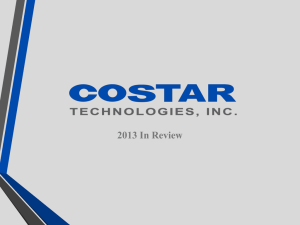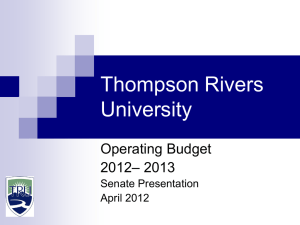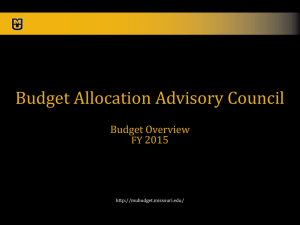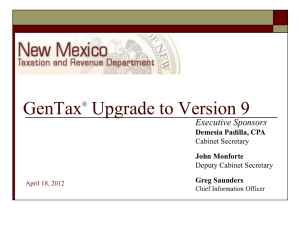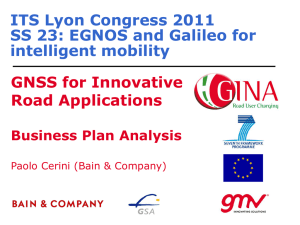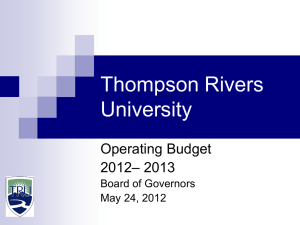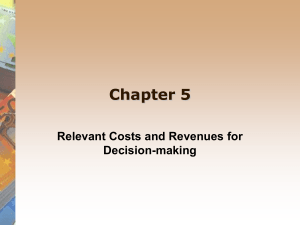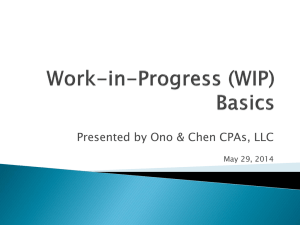Higher Education Finance Part 2-Toutkoushian
advertisement
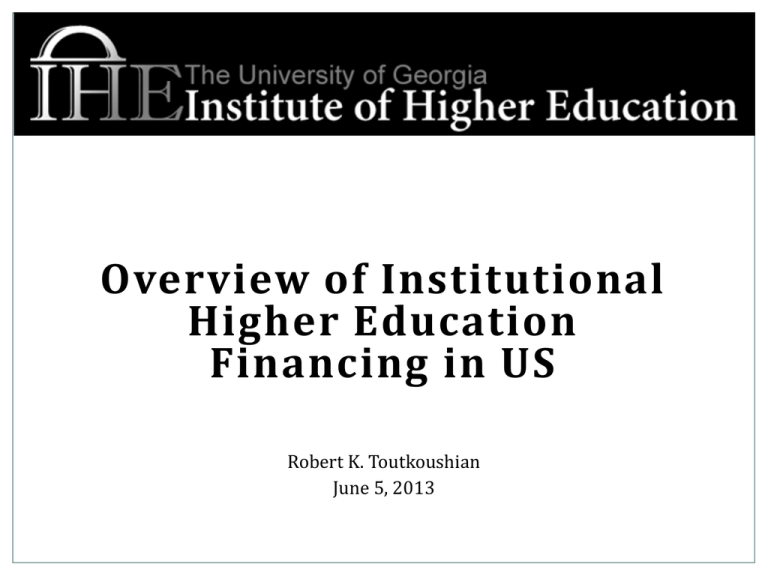
Overview of Institutional Higher Education Financing in US Robert K. Toutkoushian June 5, 2013 Overview of Presentation First presentation (yesterday): overview of system higher education financing in the United States Second presentation: overview of institutional higher education funding in the US Funding from the perspective of individual institutions Where do institutions get their money? How do institutions spend their money? How do institutions manage financial issues? Depiction of Funding Sources Total Revenues Government Students Private Donations Non-Students Other Funding Where Do Colleges Get Their Money? Tuition and fees from students 1. Tuition varies dramatically for public and private institutions Tuition at public institutions varies by residency status 2. State governments (appropriations) Funding has generally kept pace with inflation, but not costs 3. Federal governments (research) 4. Private donations 5. Revenues from auxiliary enterprises 6. Endowment Example: University of Georgia UGA Fact Book revenue by source in 2011-12 (US$) 1. 2. 3. 4. 5. 6. 7. 8. Revenues from state Tuition and fees Federal appropriations Gifts, grants and contracts Special federal funding Auxiliary enterprises Endowment Sales, Services, Misc. Total revenues = $364 million = $387 million = $ 12 million = $273 million = $ 14 million = $161 million = $ 1 million = $140 million = $1.33 billion Changes in UGA Revenue Shares Source 2002-03 2006-07 2011-12 38.0% 38.7% 27.2% Federal Appropriations 1.0% 1.1% 0.9% Tuition and Fees 15.5% 22.1% 28.9% Gifts, Grants, & Contracts 33.2% 20.3% 20.4% Auxiliary Enterprises 7.6% 11.2% 12.0% Endowment 0.1% 0.1% 0.1% Sales, Services, & Misc. 4.6% 6.5% 10.5% State Appropriations Source: UGA Fact Book 2012 • State funding has declined as a share of total revenues • Tuition and fees have increased as a share of total revenues Revenue / Prestige Cycle Increase Revenues Attract Better Faculty & Students Increase Aid & Spending Raise HEI Prestige & Ranking Seeking Out Revenues Observations on revenue streams: 1. State funding is beyond direct control of institution (but can lobby govt, meet performance incentives) 2. More emphasis on increasing grants and contracts (especially for research-oriented institutions) 3. More emphasis on raising donations & endowments 4. Incentives to become more entrepreneurial Offer special programs to raise revenues Partner with industry to provide services and generate revenues The Pricing of Education Services Tuition as a revenue source is a bit more nuanced: Varied authority to set tuition (state, system, HEI) Students charged “tuition” and “fees” Pricing constrained by demand & competitors Institutions reduce net price paid by some students by offering financial aid (“tuition discounting”) Need: Aid based on ability to pay Merit: Aid based on academic performance Other: Aid based on other attributes (ex., band, athletics) Institutional Pricing/Aid Goals 1. Increase enrollments Entice more students to enroll at the institution 2. Increase net tuition revenue 3. Change mix of students Provide more aid to desired students 4. Raise prestige Prestige affected by profile of entering class Provide more funding to high-ability students Types of Costs in Higher Education 1. Instruction – Salaries and benefits for faculty 2. Research -- Externally-funded research projects 3. Public Service – Service to community, state, nation 4. Academic Support – Expenses that support the academic mission (library, information technology) 5. Student Services – Expenses that contribute to students outside of instruction (student activities) 6. Institutional Support –Administration 7. Other Expenses Example: UGA The UGA Fact Book shows the following expenditure information for UGA in 2011-12: 1. Instruction = $249 million 2. Research = $318 million 3. Public Service = $155 million 4. Academic Support = $ 94 million 5. Student Services = $ 45 million 6. Institutional Support = $ 68 million 7. Auxiliary Enterprises = $153 million 8. Scholarships = $130 million 9. Physical Plant = $113 million Total = $1.33 billion Expenditures/Student, Public HEIs 2010-11 (US$) Category All Public 4-Year Public 2-Year Public Instruction $7,202 $9,133 $4,280 Research $2,664 $4,421 $5 Public Service $1,077 $1,673 $175 Academic Support $1,755 $2,369 $825 Student Services $1,231 $1,373 $1,016 Institutional Support $2,165 $2,606 $1,498 Plant O & M $1,710 $2,149 $1,046 Scholarships $1,597 $1,522 $1,711 Auxiliaries $1,970 $2,912 $546 All Other $5,498 $8,272 $1,296 $26,869 $36,430 $12,398 Total Source: NCES, Digest of Education Statistics 2012 Budgeting Approaches in US How do HEIs in the US allocate revenues and expenses to academic and administrative units? Two main approaches: 1. Line Item Budgeting 2. Responsibility Centered Management Line Item Budgeting Administration makes decisions on how much to increase or decrease each line item in the budget Often based on average pool of additional revenues If institution has 3% more revenues than last year to distribute, then average line item increase is 3%. Advantage: Easy to implement and understand Disadvantage: Does not provide incentive to cut back expenses or bring in more revenues May continue funding “unprofitable” activities at HEI Not clear how funding decisions are made (politics, performance?) Cross Subsidization Considerable cross-subsidization within HEIs: 1. Undergraduate students subsidize graduate 2. Low-cost majors subsidize high-cost majors 3. Academic units subsidize non-academic units that do not generate sufficient revenue to cover costs (e.g., administration) 4. Teaching subsidizes research and public service Responsibility Centered Management (RCM) An alternative to line item budgeting is “RCM” Institution is divided into “responsibility centers” or “RCs” (ex., collegiate units within HEI) Revenues are distributed to RCs based on formulas: Revenue per student (credit hours), research Each RC has to ensure that it has enough revenues to cover their expenditures May impose a “tax” to pay for HEI administration Provides incentive to cut expenses, attract funding Illustration of RCM Model w/Tax RC Unit A B C D E Administration Total Enrollment 1,000 5,000 2,000 10,000 2,000 20,000 Cost / Student = Admin / Student = Old Revenue $20,000,000 $40,000,000 $30,000,000 $60,000,000 $10,000,000 $40,000,000 $200,000,000 Gross Revenue Administrative Tax Net Revenue $10,000,000 $2,000,000 $8,000,000 $50,000,000 $10,000,000 $40,000,000 $20,000,000 $4,000,000 $16,000,000 $100,000,000 $20,000,000 $80,000,000 $20,000,000 $4,000,000 $16,000,000 $200,000,000 $40,000,000 $160,000,000 $10,000 $2,000 • Institution has $40 million in administrative costs, total budget $200 million • In RCM, distribute all revenues, then tax units to pay for administration • Administrative tax = ($2,000) x (Enroll) Observations on RCM Budgeting Good aspects: Makes HEI finances more transparent (can see how funding decisions are made) Puts decision making power closer to academic departments Provides an incentive for academic units to cut costs Provides an incentive to enroll and retain more students Bad aspects: Raises concerns about “internal competition” for students Administrative tax can be unpopular on campus Limited RC power to raise revenues (e.g., cannot set tuition) Data on HEI Finances Important to develop capacity to collect data on HEI revenues and expenditures HEIs in the US required by national government to submit data annually Data can be used by policy makers to study higher education industry Data can also be used by HEIs for comparisons, examine time trends, make projections Examples of Financial and Enrollment Trends and Issues Example: Expenditures Per Student, FY95 (US$) School Univ of Vermont Univ of Virginia Univ of Delaware UC Santa Cruz SUNY Binghamtom Univ of Rhode Island Univ of Maine Miami of Ohio Univ of Oregon U of New Hampshire (UNH) Mississippi State Utah State Univ of Colorado Instruction $7,905 $8,655 $8,458 $6,622 $5,855 $5,872 $5,342 $5,801 $5,246 $4,901 $4,483 $4,589 $5,704 Academic Student Institutional Plant & Support Services Support Maintenance $2,287 $1,091 $2,722 $2,308 $3,199 $760 $1,517 $1,299 $1,190 $737 $1,606 $1,238 $1,781 $1,798 $1,936 $1,234 $1,273 $745 $1,201 $1,300 $1,587 $1,186 $1,466 $1,379 $1,536 $1,382 $998 $1,245 $1,310 $751 $966 $1,009 $1,396 $873 $983 $781 $1,193 $533 $1,365 $824 $1,294 $470 $1,279 $1,044 $1,241 $494 $1,293 $922 $1,473 $1,257 $1,088 $733 Total $16,314 $15,430 $13,229 $13,371 $10,374 $11,490 $10,502 $9,837 $9,278 $8,815 $8,569 $8,538 $10,254 Average without UNH = $6,211 $1,631 $962 $1,421 $1,208 $11,432 %UNH above/below average = -21.1% -26.9% -44.6% -4.0% -31.8% -22.9% State Appropriations as a Share of Revenues for All Public Institutions and USNH, FY97 45% KSC & PSC Carnegie classification UNH Carnegie classification 42% 38% 40% 36% 35% 31% 30% 25% 20% 17% 16% 15% 10% 5% 0% Research Doctoral Comprehensive Baccalaureate appropriations to revenues UNH KSC/PSC Trends in Numbers of SAT Test Scores Sent to USNH Campuses, 1980 to 2007 Year Number of New Hampshire SAT Takers Sending Test Scores to USNH Institutions Percentage of All New Hampshire SAT Registrants Sending Test Scores to USNH Institutions UNH PSU KSC UNH PSU KSC 1980 3,140 974 710 39.4% 12.2% 8.9% 1985 3,201 1,024 770 39.3% 12.6% 9.5% 1990 3,952 1,470 1,434 45.2% 16.8% 16.4% 1995 3,601 1,238 1,271 38.5% 13.2% 13.6% 2000 3,433 1,217 1,351 30.9% 11.0% 12.2% 2007 3,944 1,402 1,400 30.1% 10.7% 10.7% Notes: Data obtained from College Board, New Hampshire College-Bound Seniors, annual reports 1980-2007. Data show that despite increases in number of SAT submissions to UNH, the share of SAT submissions to UNH was falling Projected Demand for UNH Projected New Hampshire Public High School Graduates Year 2006 2007 2008 2009 2010 2011 2012 2013 2014 2015 2016 2017 A P P P P P P P P P P P Lower Bound ----12,774 12,949 12,660 12,652 12,354 12,161 12,030 11,829 11,844 11,823 11,642 Middle 14,062 13,296 13,511 13,156 13,146 12,785 12,555 12,402 12,171 12,188 12,165 11,962 Upper Bound ----13,817 14,074 13,651 13,640 13,216 12,950 12,774 12,514 12,533 12,507 12,283 Projected Numbers of New Hampshire Freshmen in Four-Year Institutions from Public High Schools Four-Year Number of Change from Change from Freshmen 2006 2006 7,229 --------6,835 -394 -394 6,946 -283 -677 6,763 -466 -1,143 6,758 -471 -1,614 6,573 -656 -1,876 6,454 -775 -2,368 6,376 -853 -2,755 6,257 -972 -3,257 6,266 -963 -3,564 6,254 -975 -3,764 6,149 -1,080 -3,990 Data show falling enrollment projections due to fewer high school graduates Conclusions HEIs need revenues to enhance reputation and prestige – “arms race” in academia HEIs focus on specific revenue streams Less control over funding from state government Declining state funding has increased pressure to raise funding from other sources (students, grants, donations) New budgeting model (RCM) has promise for higher education institutions Data are needed to conduct policy analysis in higher education at both aggregate and institution levels Suggested Small Group Topics How do Croatian HEIs get their revenues? Which are growing and declining in importance? How do the budgeting models in Croatian HEIs compare to those in the US? How prevalent is tuition discounting in Croatia? How does it compare to the US? What systems are in place to collect data on revenues, expenditures, and enrollments for HEIs in Croatia and the region?
